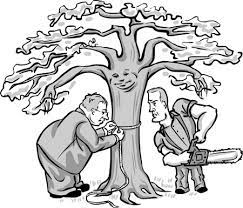 |
| AustinChronicle.com |
###
It's been 24 years since Council updated our Tree Regulations, thus we've lost MANY trees! Trees are a big part of our culture. They populate our parks, open spaces, trails, neighborhoods, and even downtown with greenery. They contribute to the riparian habitat of Bear Creek's salmon. We cherish them for their ecological benefits. A few of our treed parks and trails are regional destinations.
- For every one Landmark tree (30 inches or more) removed, six "replacement trees" (saplings) must be planted either on-site, off-site, or fee in-lieu. ($2,000.) in that order.
- For every one "Significant" tree (6 inches in diameter at breast height) removed three saplings must be planted either on-site, off-site, or fee in-lieu ($500) in that order.
- The idea is to build canopy. Redmond's goal is 40% canopy. Canopy provides cooling, carbon sequestration, wildlife habitat, aesthetics, raises property values, improves mental health, lowers blood pressure and more. Most Washington cities have a 40% canopy goal.
- For each tree removed illegally by topping the contractor's penalty will be tripled.
- Single Family Homes don't qualify for off-site or fee-in lieu options. Saplings must be shoe-horned into the parcel. If an evergreen is removed, it must be replaced by a six-foot evergreen tree. The requirements can never be enforced; no penalties.
- Find the proposed updates here: www.LetsConnectRedmond.com/
Trees
- "Redmond is at odds with another critically important goal for the community (and requirement under the Growth Management Act.); insuring adequate supply of housing."
- "Concerned enhanced retention and replacement requirements will significantly increase review times and construction costs; hampering new home construction and driving up costs."
- "This will make it increasingly difficult for the City to meet it's own housing targets and provide a range of affordable housing options."
- "The trees are getting the same protection as critical areas."
- "Reconsider a 40% canopy requirement since "American Forest" in 2017 no longer recognizes this as standard."
- "The Growth Management Act requires Redmond to responsibly provide dense housing totaling 8897 units by 2040."
Mayor Birney: "The Master Builders claim Kirkland's tree protection ordinance violates the Growth Management Act (GMA) because it failed to consider private property rights, created vague implementation standards, treated trees like critical areas without consideration of Best Available Science and will decrease housing production.
Mayor Birney: "Although we do not believe these arguments have merit, staff want to take the "Growth Management Hearings Board" conclusions into account before finalizing the ordinance for Council approval. The final Board decision on the matter is expected in November. In the meantime, staff are proposing to update the Redmond fee schedule for tree replacement and the enforcement codes to ensure that unpermitted removal is appropriately deterred until the substantive regulations can be finalized for Council adoption early in 2023."
Owing to the strength of the Planning Director Carol Helland's advice to Council, it was decided not to take action on the Proposal until November 2023 at which time the Kirkland law suit will be resolved. Council will wait until early January before implementing the new ordinance. In the process of this timeline, developers will be vested under the more lenient ordinance for another 2.3 years.
How much canopy will be removed before the new more restrictive ordinance takes place?
The Planning Director will not hire a "Code Compliance Officer."
-- Bob Yoder, 6/29/2022
For details on penalties for illegal tree removal, and to comment "Read More"
Civil penalties for illegal tree removal may exceed $1,000 for each violation.
Councilmember David Carson recommended triple penalties for tree topping.
The Administrator [Carol Helland] shall establish a tree value for each significant and landmark tree removed or damaged in violation of this chapter. Topping of trees shall be considered tree removal and shall be subject to remediation. The penalty amount shall be tripled for contractors working on behalf of a property owner and may include but not be limited to tree removal and grinding contractors and arborists.
The number of replacement trees required for illegal significant tree removal is dependent upon the size of tree removed. Illegal significant removal requires replacement tree plantings ranging from 6 and 12 plantings.
All required replacement trees and relocated trees shall be maintained in healthy condition by the property owner throughout the required bonding period of the project, unless other approved by the Administrator in a subsequent permit. [Hot summer planting must be avoided.]
Yoder, 6/29/2022
Useless. Those trees will take 50 years before they will make a difference, assuming they get sufficient water during these times of extended drought. No code enforcement.
ReplyDeleteI tend to agree with you. The City should require the developer to plant during the wet months of winter and late fall. A Code Compliance Officer is needed to follow up on the health of the plantings, as well as meeting the numbers.
ReplyDeleteThis statement comes from the city's Proposed Regulations. It's an update: "Developments that preserve 40 percent or more of the healthy significant and landmark trees shall be entitled to incentives through the GREEN BUILDING INCENTIVE. Program in RZC 21.67. under the Native Vegetation Retention technique pursuant to(RZC 21.67.050.C)."
ReplyDelete